Spatial and Temporal Analysis of Impacts of Hurricane Florence on Criteria Air Pollutants and Air Toxics in Eastern North Carolina
Abstract
:1. Introduction
2. Materials and Methods
2.1. Study Area
2.2. Mobile Air Quality Sampling for BTEX
2.3. Modeled Air Pollutant Data for Criteria Pollutants
2.4. Temporal and Geospatial Analysis of the Air Quality Data
2.5. Clustering and Spatial Correlation with Fueling Station Locations
3. Results
3.1. Spatial and Temporal Trends in BTEX after Hurricane Florence
3.2. Spatial and Temporal Trends in Criteria Air Pollutants after Hurricane Florence
3.3. Spatial Correlation with Fueling Stations
4. Discussion
5. Conclusions
Supplementary Materials
Author Contributions
Funding
Institutional Review Board Statement
Informed Consent Statement
Data Availability Statement
Acknowledgments
Conflicts of Interest
References
- Knap, A.H.; Rusyn, I. Environmental exposures due to natural disasters. Rev. Environ. Health 2016, 31, 89–92. [Google Scholar] [CrossRef] [PubMed] [Green Version]
- Faust, E.; Herweijer, C.; Knap, A.H. Physical effects of climate change from an insurance perspective. In The Insurance Industry and Climate Change—Contribution to the Global Debate; The Geneva Association: Geneva, Switzerland, 2013; Volume 133. [Google Scholar]
- Saulnier, D.D.; Brolin Ribacke, K.; von Schreeb, J. No calm after the storm: A systematic review of human health following flood and storm disasters. Prehosp. Disaster Med. 2017, 32, 568–579. [Google Scholar] [CrossRef] [PubMed]
- McMichael, A.J.; Campbell-Lendrum, D.H.; Corvalan, C.F.; Ebi, K.L.; Githeko, A.K.; Scheraga, J.D.; Woodward, A. Climate Change and Human Health: Risks and Responses; World Health Organization: Geneva, Switzerland, 2003. [Google Scholar]
- Cote, I.; Samet, J.; Vandenberg, J.J. U.S. Air quality management: Local, regional and global approaches. J. Toxicol. Environ. Health A 2008, 71, 63–73. [Google Scholar] [CrossRef]
- Manisalidis, I.; Stavropoulou, E.; Stavropoulos, A.; Bezirtzoglou, E. Environmental and health impacts of air pollution: A review. Front. Public Health 2020, 8, 14. [Google Scholar] [CrossRef] [Green Version]
- Montero-Montoya, R.; Lopez-Vargas, R.; Arellano-Aguilar, O. Volatile organic compounds in air: Sources, distribution, exposure and associated illnesses in children. Ann. Glob. Health 2018, 84, 225–238. [Google Scholar] [CrossRef] [Green Version]
- Wollin, K.M.; Damm, G.; Foth, H.; Freyberger, A.; Gebel, T.; Mangerich, A.; Gundert-Remy, U.; Partosch, F.; Rohl, C.; Schupp, T.; et al. Critical evaluation of human health risks due to hydraulic fracturing in natural gas and petroleum production. Arch. Toxicol. 2020, 94, 967–1016. [Google Scholar] [CrossRef] [PubMed]
- Saliba, G.; Saleh, R.; Zhao, Y.; Presto, A.A.; Lambe, A.T.; Frodin, B.; Sardar, S.; Maldonado, H.; Maddox, C.; May, A.A.; et al. Comparison of gasoline direct-injection (gdi) and port fuel injection (pfi) vehicle emissions: Emission certification standards, cold-start, secondary organic aerosol formation potential, and potential climate impacts. Environ. Sci. Technol. 2017, 51, 6542–6552. [Google Scholar] [CrossRef]
- Chandrappa, R.; Kulshestha, C.U. Air pollution and disasters. In Sustainable Air Pollution Management. Environmental Science and Engineering; Springer: Cham, Switzerland, 2016; pp. 325–343. [Google Scholar]
- Zirogiannis, N.; Hollingsworth, A.J.; Konisky, D.M. Understanding excess emissions from industrial facilities: Evidence from texas. Environ. Sci. Technol. 2018, 52, 2482–2490. [Google Scholar] [CrossRef]
- Zhao, G.; Yin, G.; Inamdar, A.A.; Luo, J.; Zhang, N.; Yang, I.; Buckley, B.; Bennett, J.W. Volatile organic compounds emitted by filamentous fungi isolated from flooded homes after hurricane sandy show toxicity in a drosophila bioassay. Indoor Air 2017, 27, 518–528. [Google Scholar] [CrossRef]
- Paciencia, I.; Madureira, J.; Rufo, J.; Moreira, A.; Fernandes Ede, O. A systematic review of evidence and implications of spatial and seasonal variations of volatile organic compounds (voc) in indoor human environments. J. Toxicol. Environ. Health B Crit. Rev. 2016, 19, 47–64. [Google Scholar] [CrossRef]
- U.S. EPA. Epa Needs to Improve Its Emergency Planning to Better Address Air Quality Concerns during Future Disasters; 20-P-0062; EPA: Washington, DC, USA, 2019.
- Subramanian, R.; Ellis, A.; Torres-Delgado, E.; Tanzer, R.; Malkings, C.; Rivera, F.; Morales, M.; Baumgardner, D.; Presto, A.; Mayol-Bracero, O.L. Air quality in puerto rico in the aftermath of hurricane maria: A case study on the use of lower cost air quality monitors. ACS Earth Space Chem. 2018, 2, 1179–1186. [Google Scholar] [CrossRef] [Green Version]
- Manuel, J. In Katrina’s wake. Environ. Health Perspect. 2006, 114, A32–A39. [Google Scholar] [CrossRef] [PubMed]
- Stewart, S.R.; Berg, R. Hurricane florence (al062018). In National Hurricane Center Tropical Cyclone Report; National Hurricane Center: Miami, FL, USA, 2019. [Google Scholar]
- North Carolina Department of Agriculture & Consumer Services. Multi-Hazard Threat Database. 2019. Available online: https://www.ncmhtd.com/Standards/GasStations/ (accessed on 20 April 2020).
- Zhou, Y.; Levy, J. Factors influencing the spatial extent of mobile source air pollution impacts: A meta-analysis. BMC Public Health 2007, 7, 89. [Google Scholar] [CrossRef] [Green Version]
- Bivand, R.; Piras, G. Comparing implementations of estimation methods for spatial econometrics. J. Stat. Softw. 2015, 63, 18. [Google Scholar] [CrossRef] [Green Version]
- Ord, J.K. Estimation methods for models of spatial interaction. J. Am. Stat. Assoc. 1975, 70, 349. [Google Scholar] [CrossRef]
- Benjamini, Y.; Hochberg, Y. Controlling the false discovery rate—A practical and powerful approach to multiple testing. J. R. Stat. Soc. B Met. 1995, 57, 289–300. [Google Scholar] [CrossRef]
- Moran, P.A. Notes on continuous stochastic phenomena. Biometrika 1950, 37, 17–23. [Google Scholar] [CrossRef]
- Cheng, B.; Wang-Li, L.J. Spatial and temporal variations of pm2.5 in north carolina. Aerosol Air Qual. Res. 2019, 19, 698–710. [Google Scholar] [CrossRef] [Green Version]
- Dehghani, M.; Fazlzadeh, M.; Sorooshian, A.; Reza, H.; Tabatabaee, H.R.; Miri, M.; Baghani, A.N.; Delikhoon, M.; Mahvi, A.H.; Rashidia, M. Characteristics and health effects of BTEX in a hot spot for urban pollution. Ecotoxicol. Environ. Saf. 2016, 155, 133–143. [Google Scholar] [CrossRef]
- Cruz, L.P.S.; Santos, D.F.; dos Santos, I.F.; Gomes, I.V.S.; Santos, A.V.S.; Souza, K.S.P.P. Exploratory analysis of the atmospheric levels of btex, criteria air pollutants and meteorological parameters in a tropical urban area in northeastern brazil. Microchem. J. 2020, 152, 104265. [Google Scholar] [CrossRef]
- Kashyap, P.; Kumar, A.; Kumar, K. Btex concentrations and associated health risks at urban vegetative sites in Delhi, India. Environ. Claims J. 2019, 31, 349–365. [Google Scholar] [CrossRef]
- Pankow, J.F.; Luo, W.T.; Bender, D.A.; Isabelle, L.M.; Hollingsworth, J.S.; Chen, C.; Asher, W.E.; Zogorski, J.S. Concentrations and co-occurrence correlations of 88 volatile organic compounds (vocs) in the ambient air of 13 semi-rural to urban locations in the united states. Atmos. Environ. 2003, 37, 5023–5046. [Google Scholar] [CrossRef]
- Monod, A.; Sive, B.; Avino, P.; Chen, T.; Blake, D.; Sherwood Rowland, F. Monoaromatic compounds in ambient air of various cities: A focus on correlations between the xylenes and ethylbenzene. Atmos. Environ. 2001, 35, 135–149. [Google Scholar] [CrossRef] [Green Version]
- U.S. EPA. 2014 National Air Toxics Assessment. 2018. Available online: https://www.epa.gov/national-air-toxics-assessment/2014-national-air-toxics-assessment (accessed on 20 April 2020).
- Hilpert, M.; Rule, A.M.; Adria-Mora, B.; Tiberi, T. Vent pipe emissions from storage tanks at gas stations: Implications for setback distances. Sci. Total Environ. 2019, 650, 2239–2250. [Google Scholar] [CrossRef] [PubMed]
- Yerushalmi, L.; Rastan, S. Evaporative losses from retail gasoline outlets and their potential impact on ambient and indoor air quality. In 8th International Symposium on Heating, Ventilation and Air Conditioning; Li, A., Zhu, Y., Li, Y., Eds.; Springer: Cham, Switzerland, 2014; pp. 13–21. [Google Scholar]
- Statistics Canada. Gasoline Evaporative Losses from Retail Gasoline Outlets Across Canada, 2009; Vol. Catalogue no. 16-001-M, no. 15; Statistics Canada: Ottawa, ON, Canada, 2009.
- Biesecker, M.; Kastanis, A. Hurricane Florence Breaches Manure Lagoon, Coal Ash Pit in North Carolina; PBS News Hour: Washington, DC, USA, 2018. [Google Scholar]
- Aly, N.A.; Casillas, G.; Luo, Y.S.; McDonald, T.J.; Wade, T.L.; Zhu, R.; Newman, G.; Lloyd, D.; Wright, F.A.; Chiu, W.A.; et al. Environmental impacts of hurricane florence flooding in eastern north carolina: Temporal analysis of contaminant distribution and potential human health risks. J. Expo. Sci. Environ. Epidemiol. 2021, 31, 810–822. [Google Scholar] [CrossRef]
- Jang, S.; McDonald, T.J.; Bhandari, S.; Rusyn, I.; Chiu, W.A. Spatial and temporal distribution of surface water contaminants in the houston ship channel after the intercontinental terminal company fire. J. Expo. Sci. Environ. Epidemiol. 2021, 31, 887–899. [Google Scholar] [CrossRef]
- Aly, N.A.; Luo, Y.S.; Liu, Y.; Casillas, G.; McDonald, T.J.; Kaihatu, J.M.; Jun, M.; Ellis, N.; Gossett, S.; Dodds, J.N.; et al. Temporal and spatial analysis of per and polyfluoroalkyl substances in surface waters of houston ship channel following a large-scale industrial fire incident. Environ. Pollut. 2020, 265, 115009. [Google Scholar] [CrossRef]
- Valdiviezo, A.; Aly, N.A.; Luo, Y.-S.; Cordova, A.; Casillas, G.; Foster, M.; Baker, E.S.; Rusyn, I. Analysis of per- and polyfluoroalkyl substances in houston ship channel and galveston bay following a large-scale industrial fire using ion-mobility-spectrometry-mass spectrometry. J. Environ. Sci. 2022, 115, 350–362. [Google Scholar] [CrossRef]
- Sorek-Hamer, M.; Chatfield, R.; Liu, Y. Review: Strategies for using satellite-based products in modeling pm2.5 and short-term pollution episodes. Environ. Int. 2020, 144, 106057. [Google Scholar] [CrossRef] [PubMed]
- Huang, M.; Wu, X. A review of air quality monitoring system based on crowdsensing. In Proceedings of the International Symposium for Intelligent Transportation and Smart City (ITASC) 2019 Proceedings, Singapore, 9–11 May 2019; Zeng, X., Xie, X., Sun, J., Ma, L., Chen, Y., Eds.; Springer: Singapore, 2019; pp. 286–296. [Google Scholar]
- Chambliss, S.E.; Preble, C.V.; Caubel, J.J.; Cados, T.; Messier, K.P.; Alvarez, R.A.; LaFranchi, B.; Lunden, M.; Marshall, J.D.; Szpiro, A.A.; et al. Comparison of mobile and fixed-site black carbon measurements for high-resolution urban pollution mapping. Environ. Sci. Technol. 2020, 54, 7848–7857. [Google Scholar] [CrossRef]
- Apte, J.S.; Messier, K.P.; Gani, S.; Brauer, M.; Kirchstetter, T.W.; Lunden, M.M.; Marshall, J.D.; Portier, C.J.; Vermeulen, R.C.H.; Hamburg, S.P. High-resolution air pollution mapping with google street view cars: Exploiting big data. Environ. Sci. Technol. 2017, 51, 6999–7008. [Google Scholar] [CrossRef] [PubMed]
- Peters, J.; Theunis, J.; Van Poppel, M.; Berghmans, P. Monitoring pm10 and ultrafine particles in urban environments using mobile measurements. Aerosol Air Qual. Res. 2013, 13, 509–522. [Google Scholar] [CrossRef]
- Alexeeff, S.E.; Roy, A.; Shan, J.; Liu, X.; Messier, K.; Apte, J.S.; Portier, C.; Sidney, S.; Van Den Eeden, S.K. High-resolution mapping of traffic related air pollution with google street view cars and incidence of cardiovascular events within neighborhoods in oakland, ca. Environ. Health 2018, 17, 38. [Google Scholar] [CrossRef] [Green Version]
- Gani, S.; Chambliss, S.E.; Messier, K.P.; Lunden, M.M.; Apte, J.S. Spatiotemporal profiles of ultrafine particles differ from other traffic-related air pollutants: Lessons from long-term measurements at fixed sites and mobile monitoring. Environ. Sci. Atmos. 2021, 1, 558–568. [Google Scholar] [CrossRef]
- Vardoulakis, S.; Solazzo, E.; Lumbreras, J. Intra-urban and street scale variability of btex, no2 and o3 in Birmingham, UK: Implications for exposure assessment. Atmos. Environ. 2011, 45, 5069–5078. [Google Scholar] [CrossRef]
- Lu, T.; Lansing, J.; Zhang, W.; Bechle, M.J.; Hankey, S. Land use regression models for 60 volatile organic compounds: Comparing google point of interest (poi) and city permit data. Sci. Total Environ. 2019, 677, 131–141. [Google Scholar] [CrossRef]
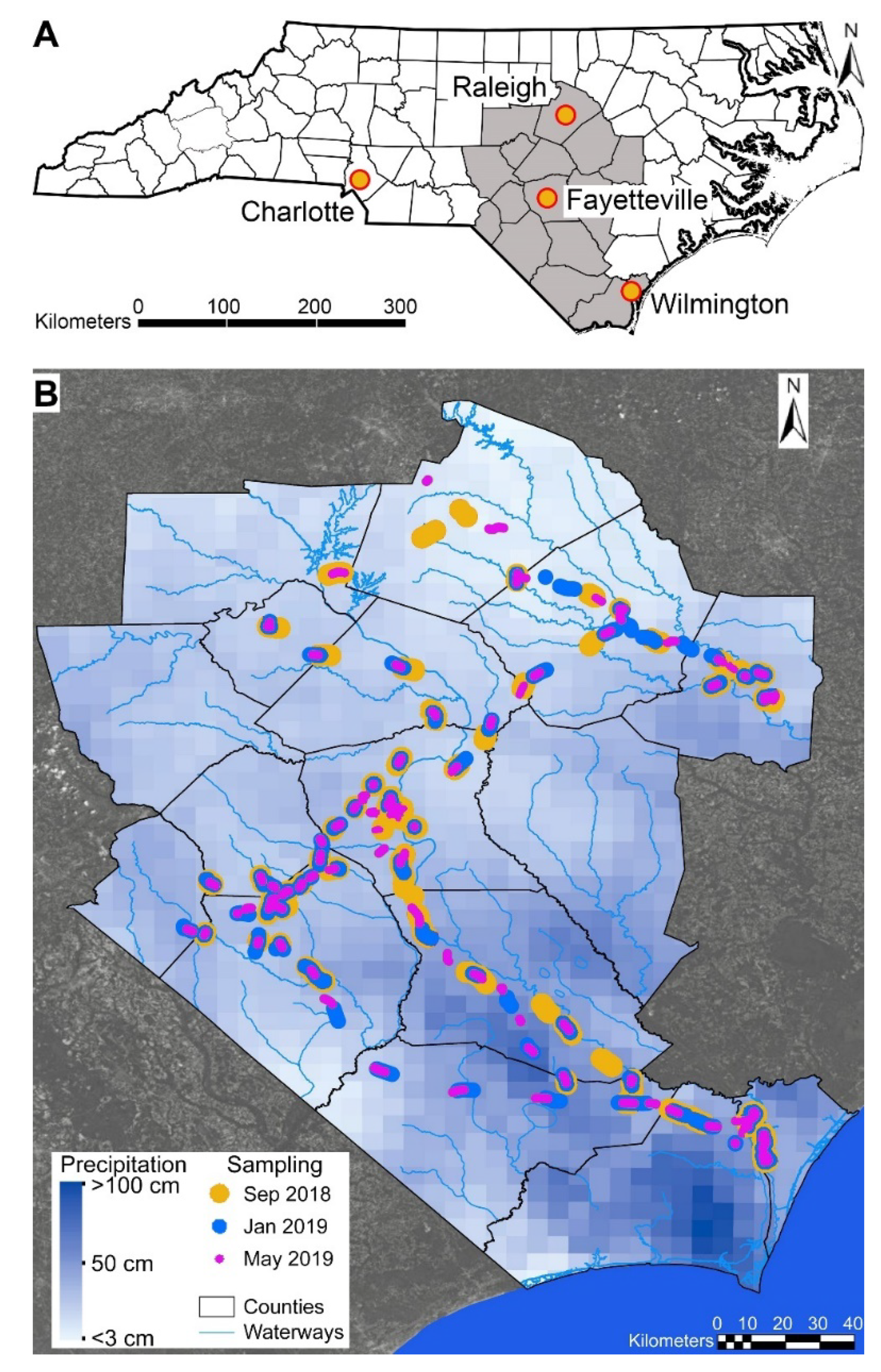
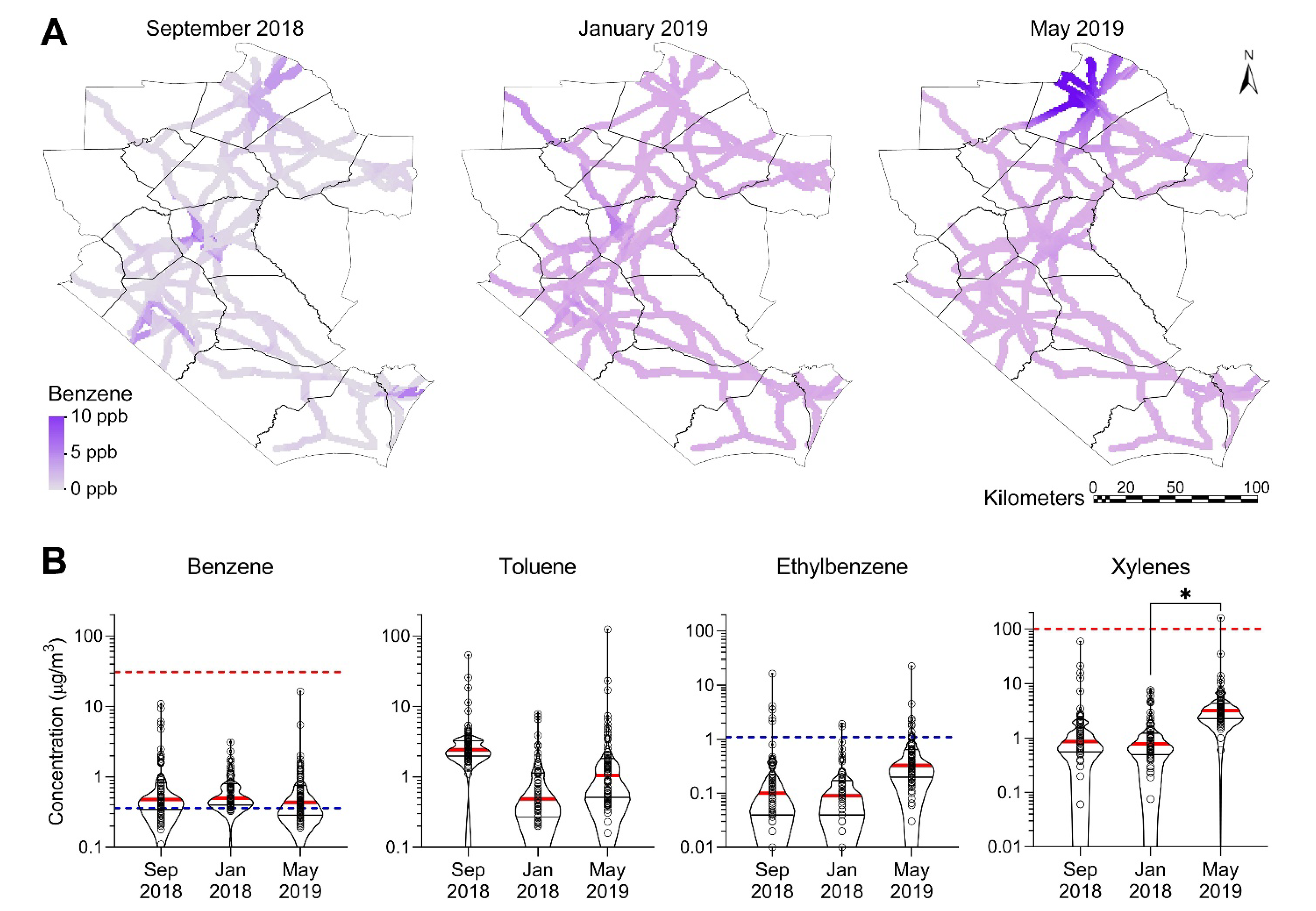
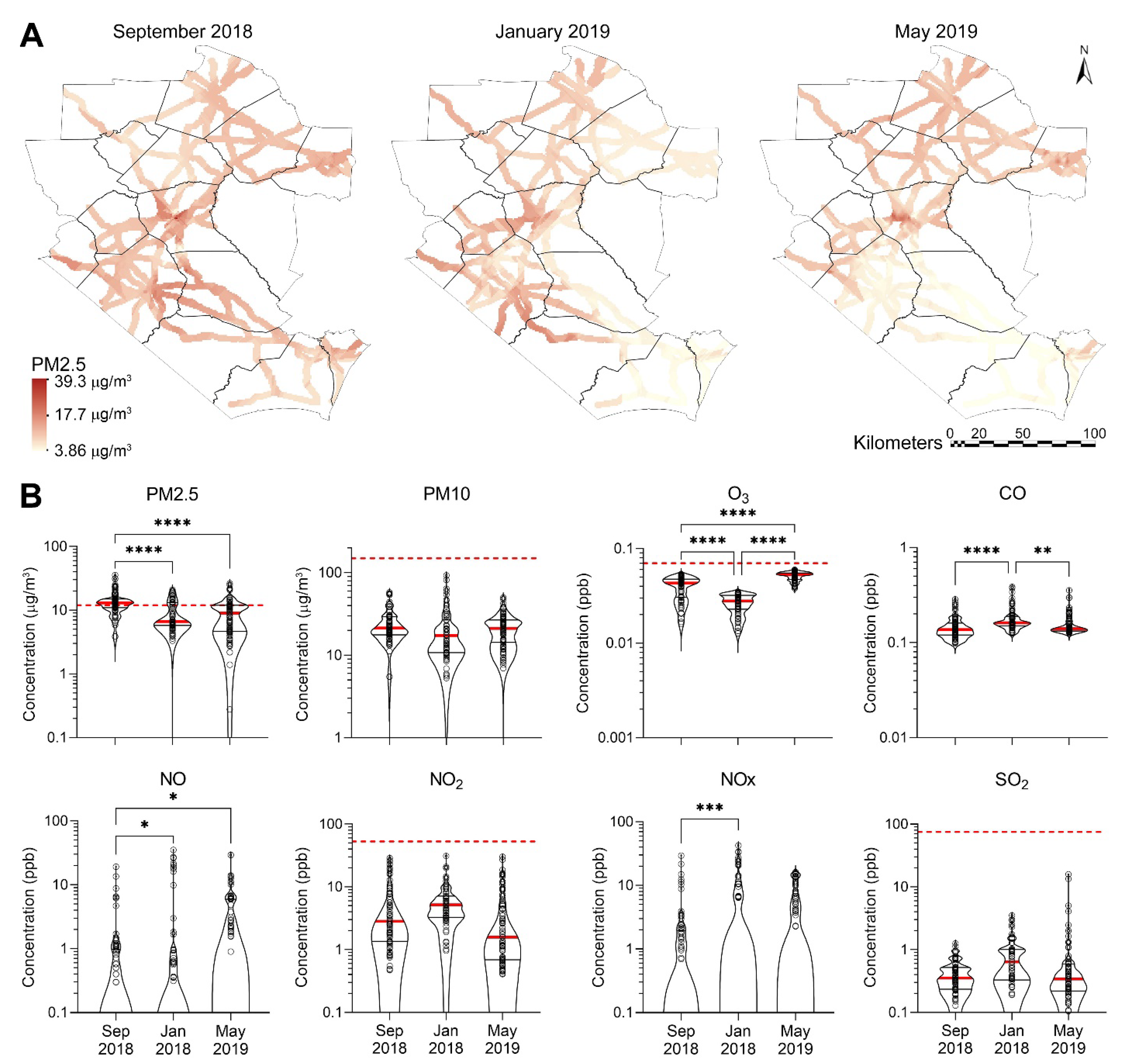
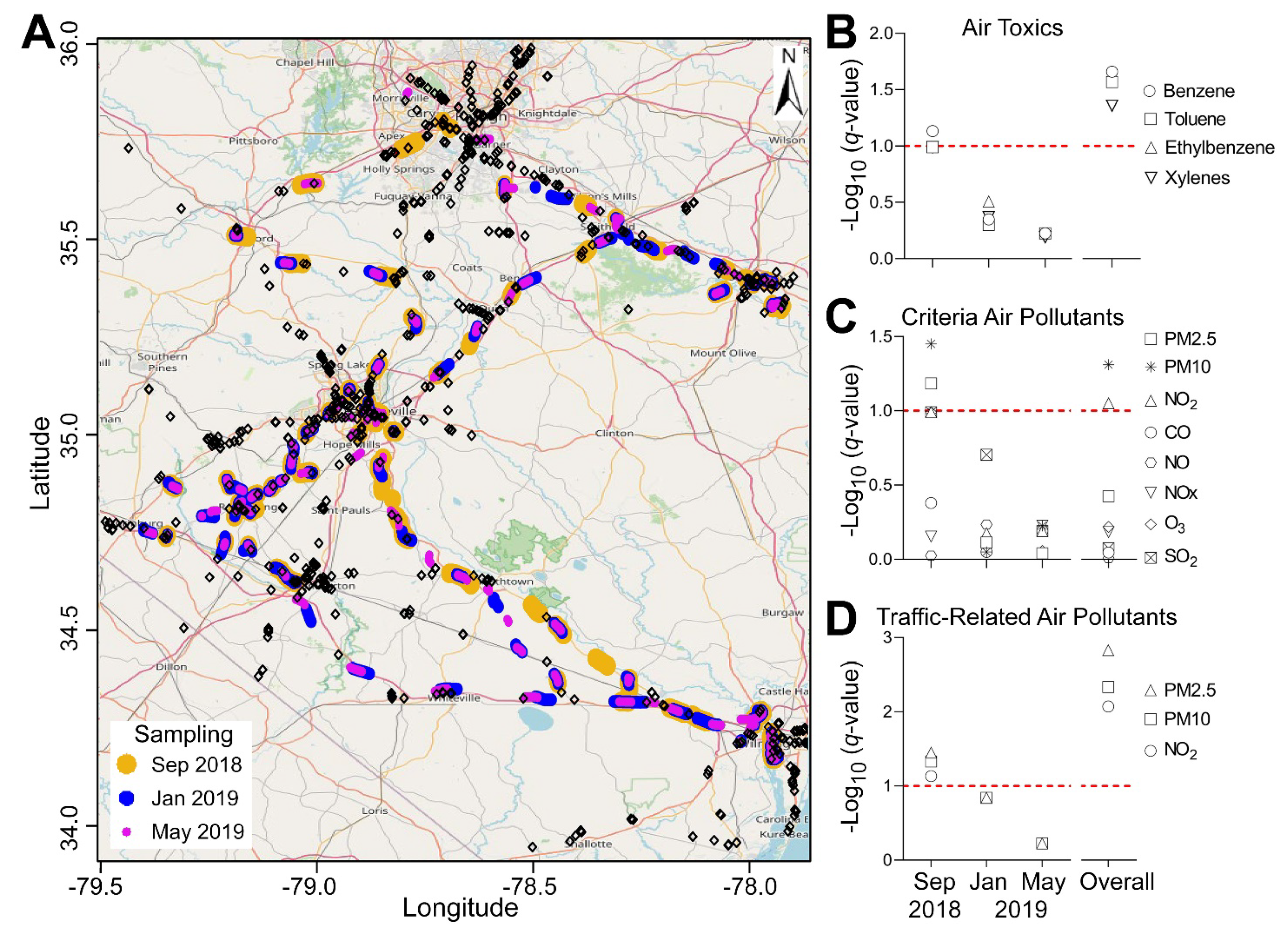
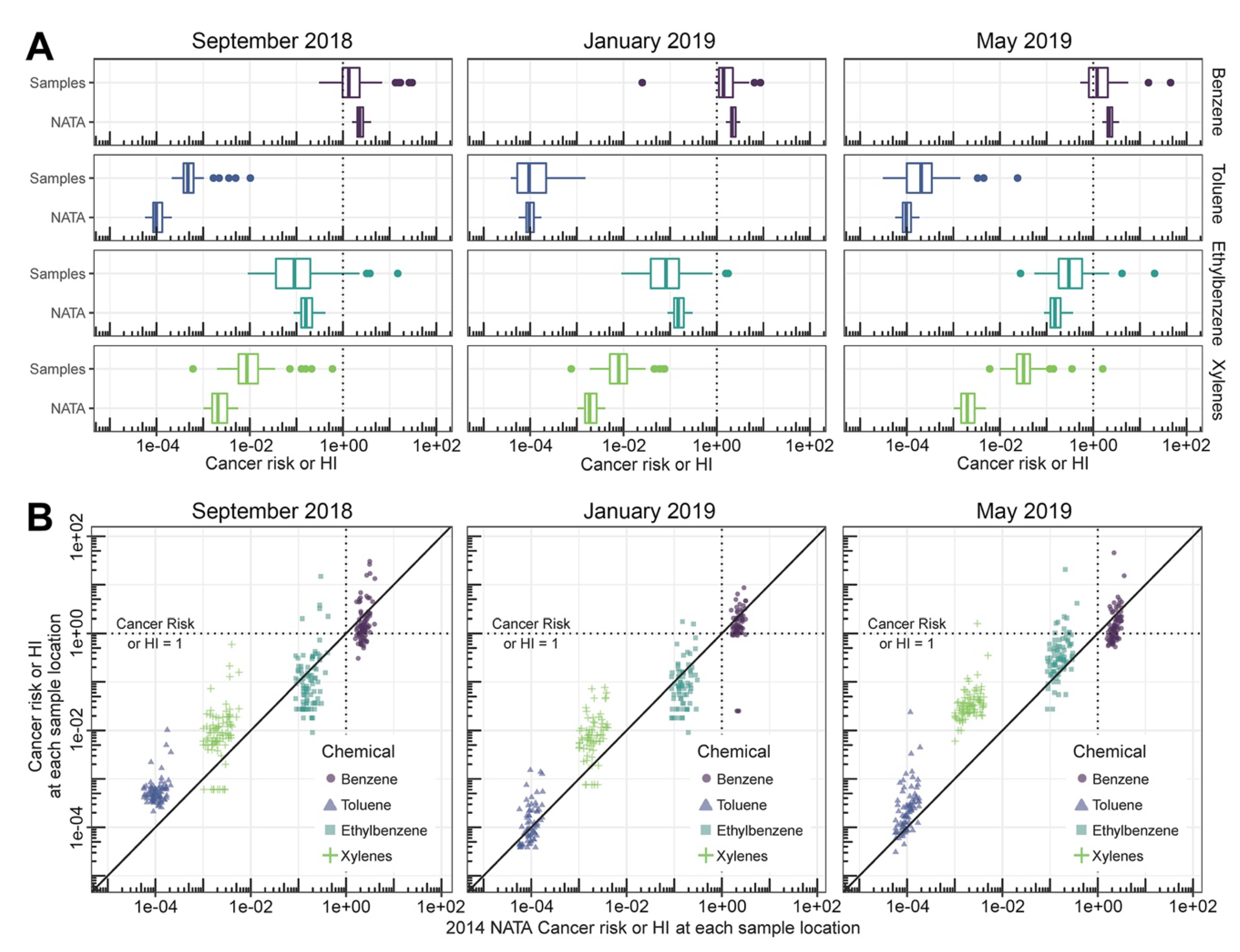
| Min. | 1st Qu. | Median | Mean | 3rd Qu. | Max. | %>RSL a | |
|---|---|---|---|---|---|---|---|
| Benzene (μg/m3) | |||||||
| September 2018 | 0.11 | 0.35 | 0.48 | 1.0 | 0.82 | 11 | 74% |
| January 2019 | 0.0091 | 0.40 | 0.50 | 0.69 | 0.80 | 3.1 | 87% |
| May 2019 | 0.19 | 0.29 | 0.44 | 0.81 | 0.74 | 16 | 62% |
| Toluene (μg/m3) | |||||||
| September 2018 | 0.0061 | 2.0 | 2.4 | 3.7 | 3.2 | 53 | 0% |
| January 2019 | 0.0030 | 0.28 | 0.49 | 1.0 | 1.1 | 7.9 | 0% |
| May 2019 | 0.16 | 0.52 | 1.1 | 3.3 | 1.8 | 120 | 0% |
| Ethylbenzene (μg/m3) | |||||||
| September 2018 | 0.010 | 0.04 | 0.1 | 0.46 | 0.22 | 16 | 6% |
| January 2019 | 0.010 | 0.042 | 0.09 | 0.18 | 0.17 | 1.9 | 3% |
| May 2019 | 0.030 | 0.20 | 0.33 | 0.80 | 0.64 | 23 | 12% |
| Xylenes (μg/m3) | |||||||
| September 2018 | 0.061 | 0.58 | 0.87 | 2.3 | 1.5 | 59 | 0% |
| January 2019 | 0.076 | 0.51 | 0.79 | 1.3 | 1.2 | 7.6 | 0% |
| May 2019 | 0.60 | 2.3 | 3.2 | 5.9 | 4.4 | 160 | 1% |
| Min. | 1st Qu. | Median | Mean | 3rd Qu. | Max. | %>NAAQS a | |
|---|---|---|---|---|---|---|---|
| PM2.5 (μg/m3) | |||||||
| September 2018 | 3.8 | 11 | 13 | 14 | 15 | 36 | 66% |
| January 2019 | 0.00 | 5.7 | 6.7 | 9.2 | 13 | 21 | 30% |
| May 2019 | 0.28 | 4.7 | 9.0 | 9.2 | 12 | 26 | 22% |
| PM10 (μg/m3) | |||||||
| September 2018 | 5.5 | 18 | 21 | 24 | 29 | 58 | 0% |
| January 2019 | 0.00 | 11 | 17 | 22 | 26 | 93 | 0% |
| May 2019 | 7.0 | 14 | 21 | 22 | 26 | 50 | 0% |
| O3 (ppb) | |||||||
| September 2018 | 16 | 31 | 43 | 40 | 48 | 54 | 0% |
| January 2019 | 0.00 | 23 | 28 | 26 | 32 | 35 | 0% |
| May 2019 | 38 | 47 | 53 | 52 | 55 | 60 | 0% |
| CO (ppb) | |||||||
| September 2018 | 99 | 121 | 137 | 144 | 160 | 286 | 0% |
| January 2019 | 0.00 | 150 | 162 | 178 | 187 | 387 | 0% |
| May 2019 | 127 | 133 | 141 | 158 | 169 | 355 | 0% |
| NO (ppb) | |||||||
| September 2018 | 0.00 | 0.00 | 0.00 | 1.06 | 0.96 | 19 | NA |
| January 2019 | 0.00 | 0.00 | 0.00 | 3.3 | 1.0 | 35 | NA |
| May 2019 | 0.00 | 0.00 | 0.00 | 3.1 | 5.9 | 29 | NA |
| NO2 (ppb) | |||||||
| September 2018 | 0.47 | 1.4 | 2.8 | 5.9 | 7.5 | 29 | 0% |
| January 2019 | 0.00 | 3.3 | 5.2 | 6.2 | 7.1 | 31 | 0% |
| May 2019 | 0.41 | 0.69 | 1.6 | 4.5 | 6.1 | 30 | 0% |
| NOX (ppb) | |||||||
| September 2018 | 0.00 | 0.00 | 0.00 | 2.0 | 1.9 | 29 | NA |
| January 2019 | 0.00 | 0.00 | 0.00 | 6.4 | 10 | 43 | NA |
| May 2019 | 0.00 | 0.00 | 0.00 | 4.2 | 7.4 | 16 | NA |
| SO2 (ppb) | |||||||
| September 2018 | 0.00 | 0.23 | 0.35 | 0.42 | 0.52 | 1.3 | 0% |
| January 2019 | 0.00 | 0.32 | 0.61 | 0.81 | 0.99 | 3.51 | 0% |
| May 2019 | 0.00 | 0.22 | 0.34 | 0.89 | 0.59 | 16 | 0% |
Publisher’s Note: MDPI stays neutral with regard to jurisdictional claims in published maps and institutional affiliations. |
© 2022 by the authors. Licensee MDPI, Basel, Switzerland. This article is an open access article distributed under the terms and conditions of the Creative Commons Attribution (CC BY) license (https://creativecommons.org/licenses/by/4.0/).
Share and Cite
Bhandari, S.; Casillas, G.; Aly, N.A.; Zhu, R.; Newman, G.; Wright, F.A.; Miller, A.; Adler, G.; Rusyn, I.; Chiu, W.A. Spatial and Temporal Analysis of Impacts of Hurricane Florence on Criteria Air Pollutants and Air Toxics in Eastern North Carolina. Int. J. Environ. Res. Public Health 2022, 19, 1757. https://doi.org/10.3390/ijerph19031757
Bhandari S, Casillas G, Aly NA, Zhu R, Newman G, Wright FA, Miller A, Adler G, Rusyn I, Chiu WA. Spatial and Temporal Analysis of Impacts of Hurricane Florence on Criteria Air Pollutants and Air Toxics in Eastern North Carolina. International Journal of Environmental Research and Public Health. 2022; 19(3):1757. https://doi.org/10.3390/ijerph19031757
Chicago/Turabian StyleBhandari, Sharmila, Gaston Casillas, Noor A. Aly, Rui Zhu, Galen Newman, Fred A. Wright, Anthony Miller, Gabriela Adler, Ivan Rusyn, and Weihsueh A. Chiu. 2022. "Spatial and Temporal Analysis of Impacts of Hurricane Florence on Criteria Air Pollutants and Air Toxics in Eastern North Carolina" International Journal of Environmental Research and Public Health 19, no. 3: 1757. https://doi.org/10.3390/ijerph19031757
APA StyleBhandari, S., Casillas, G., Aly, N. A., Zhu, R., Newman, G., Wright, F. A., Miller, A., Adler, G., Rusyn, I., & Chiu, W. A. (2022). Spatial and Temporal Analysis of Impacts of Hurricane Florence on Criteria Air Pollutants and Air Toxics in Eastern North Carolina. International Journal of Environmental Research and Public Health, 19(3), 1757. https://doi.org/10.3390/ijerph19031757






